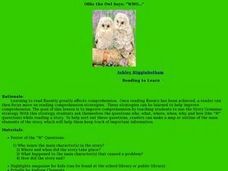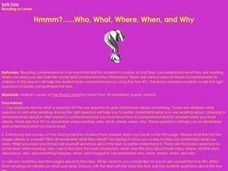Curated OER
The 5 W's
Examine how to answer who, what, when, where, and why when reading text. Young writers listen to the story Skeleton Hiccups, and as a class answer and discuss the five W's. Independently they read the story silently, and write the...
Curated OER
Ollie the Own Says: WHO
Scholars examine the strategy of making a story map or outline to identify the main elements of a story. They discuss the who, what, where, when, why, and how of a story, in an outline form. As a class they read a short story, answer the...
Curated OER
Comprehending Through Questioning
Elementary schoolers observe and apply a variety of reading comprehension strategies. They silently read a passage out of their science textbook, and discuss answering the who, what, where, when, and how of the text. In small groups they...
Curated OER
Sum It Up !!
Students practice various comprehension strategies to generate the main idea of the text. They encounter unfamiliar concepts and new vocabulary in their quest of the main idea in "Watson's Goes to Burmingham." The Five W's (What, Where,...
Curated OER
Summing It All Up in a Nutshell
Students observe and demonstrate a variety of summarization strategies. They discuss the process of asking the five W questions, and apply then to a passage from the book "Sarah Plain and Tall." Students then finish the chapter from...
Curated OER
Hmmm...Who, What, Where, When, and Why
Students practice reading comprehension by answering the 5 "W" questions. After reading "The Kissing Hand," they complete a class discussion addressing the questions who, what, when, where, and why. Students choose an appropriate,...
Curated OER
Chinese Zodiac
Fifth graders identify the basic elements of a narrative story, such as the beginning, middle, and the end; to analyze the character traits in the story to write a summary using the 5 Ws and How chart included; through sample stories...
Curated OER
Summarization Safari
Students summarize a piece of fiction text. After reviewing the correct way to question while reading, students independently read a short story. They complete a summary organizer using the five Ws outlined by the instructor during...
Curated OER
It's Raining Meatballs
Students observe and demonstrate the process of summarization using the book "Cloudy With a Chance of Meatballs" by Judi Barrett. They silently read the story, and as a class discuss the five W's. Students then write a short summary of...
Curated OER
Summarization
Students summarize a selected piece of text using the five Ws. After reviewing the correct way to read silently, students read a selected piece of nonfiction text. They write a summary paragraph using a process outlined by the instructor.
Curated OER
The Name Jar
Students participate in a lesson that focuses on the literature of Korea. "The Name Jar" is read by students to practice some essential reading skills. This would include the recognition of sequence in a story, characterization, and...
Curated OER
Short Story
Seventh graders identify the various elements of a short story. After reading Rudyard Kipling's short story, "Rikki-Tikki-Tavi," students identify the author's purpose in writing the story as well as the elements that make it a short...
Curated OER
It's Raining Cats and Dog: Studying Idioms
Seventh graders determine the literal and figurative meanings of idioms and research the history of idioms. In this idioms lesson plan, 7th graders read two books by Fred Gwynne and select two idioms from the texts to research. Students...
Curated OER
Lesson 3: Writing a News Story
Start a writing lesson by examining a news video that explains writing clearly, concisely, and correctly. Learners consider the importance of writing news properly to avoid breaking the law, then write their own weekend news stories.















